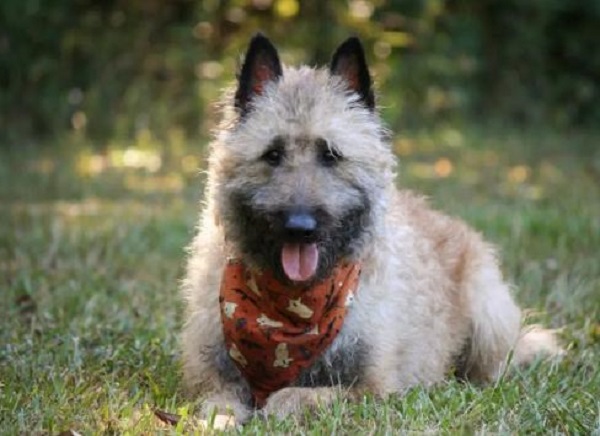Dive into the world of the Belgian Laekenois, a unique herding breed from Belgium known for its athleticism and distinctive appearance. In this article, we’ll explore the essential traits that make the Laekenois stand out, its pronunciation (“Lak-in-wah”), and the captivating personality that makes it an excellent protector and affectionate companion. Unveil the key characteristics and get essential care tips for those interested in this remarkable breed.

Brief facts on the Belgian Laekenois canine
- Origin: Belgium
- Size: Stands 22-26 inches tall at the shoulder, weighing between 44-66 pounds
- Lifespan: Typically lives 12-14 years
- Appearance: Boasts a rough, wiry coat available in shades of red, fawn, or gray
- Temperament: Exhibits intelligence, alertness, and high activity levels. Proven as excellent watchdogs and family pets.
- Energy Level: Maintains a high level of energy
- Training: Moderately challenging due to high intelligence and eagerness to please
- Grooming: Requires brushing 2-3 times a week and monthly hand-stripping
- Exercise: Needs a minimum of 60 minutes of daily exercise
- Health: Generally healthy, with a susceptibility to conditions like hip dysplasia and elbow dysplasia
History of the Belgian Laekenois
Long ingrained in Belgian history, the Belgian Laekenois was developed centuries ago among indigenous herding breeds. At first these dogs were devoted protectors of animals, especially sheep and cattle, and they formed strong bonds with their human friends. Over time, they developed into adept working dogs and watchful defenders, and their function grew.
Based on distinctive coat patterns, Belgian shepherds—including the Laekenois—were formally divided into four categories in the 1890s: Groenendael, Malinois, Tervuren, and Laekenois. The town of Laeken, which is closely associated with the Laekenois, gave rise to the name of this distinctive breed of dog known for its wiry, curly coat. These canines had an interesting side job as protectors of linen drying in fields, in addition to herding livestock.
Despite the relative scarcity of the breed, dedicated fans fought tirelessly to conserve the Laekenois and other shepherd lineages despite the obstacles given by the upheavals of World Wars I and II.
The Laekenois, when it was brought to America, quickly became popular with owners, breeders, and exhibitors. A turning point was the founding of the American Belgian Laekenois Association in 1995. In 1998, the breed became eligible to compete in the Companion category by joining the AKC’s Foundation Stock Service. As it advanced through the ranks, on July 1, 2020, it was fully acknowledged in the esteemed Herding group. The history of the Belgian Laekenois bears witness to its adaptability, durability, and allure.
Features of Laekenois Belgium

The Belgian Laekenois dog’s appearance
Personality of Belgian Laekenois
The Belgian Laekenois thrives on satisfying its human counterparts and is a devoted and watchful friend. Because of the breed’s innate intelligence, training works best when it is consistent, calm, and uses positive reinforcement. It is essential to socialize children early to stop aggressive or territorial behavior.
Laekenois dogs love playing and playing with toys that stimulate their minds, even if they are not very active. Their playtime pinching may be the result of herding tendencies, which calls for a little warning. These dogs may find it difficult to spend long amounts of time alone, underscoring the need of interaction to avoid bad tendencies brought on by boredom. In spite of this, they adjust to apartment life well, avoiding extended periods of isolation with frequent walks and plenty playfulness.
Size of Belgian Laekenois
Male Belgian Laekenois typically weigh between 55 and 66 pounds and have a shoulder height of 24 to 26 inches. Females, on the other hand, are somewhat smaller, weighing between 44 and 55 pounds and often standing between 22 and 24 inches tall.
It’s important to recognize that breed variances in size exist, with certain Belgian Laekenois individuals potentially falling outside of the typical range.
Care of Belgian Laekenois
The Belgian Laekenois, bred for labor, has a keen brain even if it is generations and kilometers removed from its sheepfold roots in Belgium. This dog is naturally energetic and always aware. If they don’t get enough exercise and attention, they could behave in a willful, destructive, and neurotic manner. Regular grooming is crucial, adding to the weekly care regimen for these exceptional and uncommon canines, in addition to exercise and training.
Diet and Nutrition
Giving your Belgian Laekenois a diet rich in premium dog food and occasional treats can help them stay healthy. Treats and leftover table scraps in excess might negatively impact your dog’s weight and general health.
It is recommended to give preference to hard, crunchy kibble over wet food in order to treat oral health issues in this breed. Making this decision helps to avoid plaque accumulation. Choose a diet that avoids foods that your dog is known to have allergies to, and work with your veterinarian to figure out the right portion sizes for your dog’s age, weight, and activity level. Long-term vitality of your Belgian Laekenois is influenced by regular attention to their dietary demands.
Exercise
A devoted workout regimen is essential to an Laekenois’s physical and emotional well-being. Try to set aside around two hours a day for both exercise and mental activity. Realizing that you can’t outwork a Belgian shepherd, you need to provide a strong physical release in addition to psychologically engaging training sessions.
Laekenois find that agility training is a great way to exercise as it enhances their innate ability to take on new tasks. Dog sports like agility provide the ideal mix of mental and physical strain. Use interactive activities like fetch and puzzle toys to keep your Laekenois occupied and entertained inside. This all-encompassing method of fitness meets the specific requirements of the Belgian Laekenois by addressing the demands of the body and mind.
Grooming
The Laekenois requires regular grooming, but it doesn’t have to take a lot of time. For a about 2 1/2-inch-long, tousled coat, brushing once a week is advised to avoid matting and remove any debris. The coat’s double layer, which naturally controls body temperature, should not be clipped.
Regular grooming care is crucial, and includes things like inspecting your dog’s ears, cutting nails, and cleaning their teeth. Use a cotton ball dipped in a particular ear cleaning solution as required to clean your ears and keep out debris and grime that might cause infections. This simple grooming regimen guarantees your Laekenois’ health and cleanliness without requiring an unduly long time investment.
Training
Obedience training around six to eight weeks of age is very beneficial for Laekenois, since they mature quickly. This paves the way for more sophisticated instruction while also establishing the owner as the pack leader.
Given the breed’s innate feeling of responsibility to protect, obedience training is essential to strengthening the link between owner and shepherd. Sustaining leadership is essential for reining in impulsive behavior. Early socialization—which is started after vaccination—improves adaptation by introducing Laekenois to a variety of settings.
Owners observe increased apprehension, particularly at night, highlighting the need of continual socializing and training. When introduced appropriately, Laekenois often get along with other animals despite their protective tendencies. But because of their herding instinct, they may be a little mouthy; to control this behavior, they need regular training and plenty of exercise.
Issues with Belgian Laekenois dogs’ health
Belgian Laekenois dogs are strong canines in general, but since they are a big breed, certain health checkups are essential. Reputable breeders screen parent dogs thoroughly and provide the medical history of the litter to potential adopters.
The American Belgian Laekenois Association recommends checks for hip and elbow screens, thyroid and heart exams, ophthalmology exams, and dental exams. Laekenois often have the following health problems:
- Skin Allergies: Commonly caused by dietary or environmental allergies, these conditions may Cause itchy, red, or irritated skin.
- Elbow and hip dysplasia: Occurs often in big breeds; results from deformity of the joint during development.
Heart Issues: For early diagnosis and timely treatment, a number of disorders need for routine veterinary testing. - Progressive Retinal Atrophy: A degenerative eye disorder called progressive retinal atrophy may eventually cause blindness.
- Epilepsy: A neurological condition that results in seizures that may be controlled in mild to severe instances with medicine.
- Hypothyroidism: Underactive thyroid that prevents hormone production is known as hypothyroidism.
- Dental Issues: For conditions including periodontal disease and dental difficulties, regular veterinarian examinations are essential.
Belgian Laekenois dog cost
A Belgian Laekenois requires careful thought before purchase. Consider if you are prepared to provide daily care for them given their unique demands and uniqueness. You may have trouble finding them at shelters, so look into alternatives in your area or get in touch with rescue groups that specialize in a certain breed.
Careful investigation is essential in choosing an Laekenois puppy from a breeder. Importing is a possibility since there aren’t many breeders in the US. Make sure to include inquiries on the parentage that may impact a puppy’s characteristics and overall well-being.
Based on availability and lineage, laekenois pups from respectable breeders may cost anywhere from $650 to $2,500. In order to ensure a seamless transition into your household, carefully evaluate your resources and level of commitment prior to adopting.
Can the Belgian Laekenois get along with other animals?
The Belgian Laekenois can be an excellent family dog, but their herding instincts and protective nature should be taken into account when considering compatibility with other animals. While they may form strong bonds with older children, their inclination to herd and nip can pose challenges with toddlers.

When it comes to coexisting with other animals, the Laekenois may be best suited as the only pet in the household. This precaution is taken to prevent potential conflicts, especially with smaller dogs and cats. Proper training, early socialization, and careful supervision, however, can foster positive interactions and help ensure a harmonious living environment for all.
